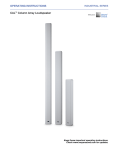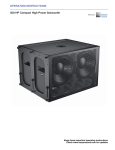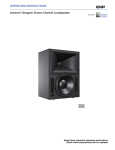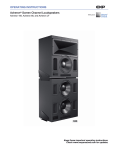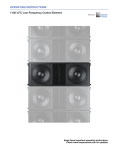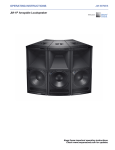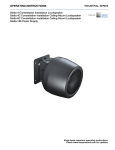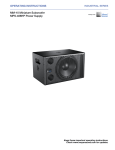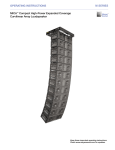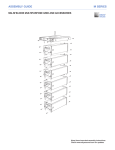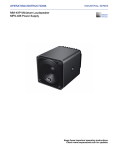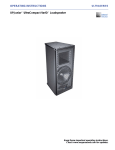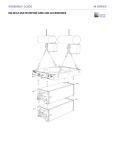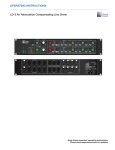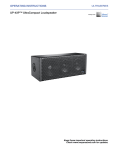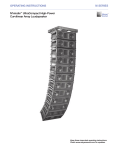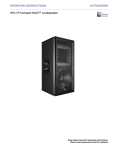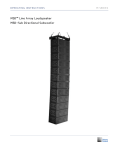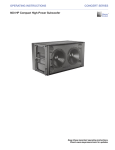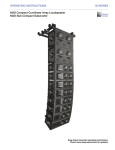Download Mercedes-Benz S500 Automobile User Manual
Transcript
OPERATING INSTRUCTIONS M SERIES MINA Compact Curvilinear Array Loudspeaker Keep these important operating instructions. Check www.meyersound.com for updates. DECLARATION OF CONFORMITY ACCORDING TO ISO/IEC GUIDE 22 AND EN 45014 Manufacturer’s Name: Meyer Sound Laboratories Inc. Manufacturer’s Address: 2832 San Pablo Avenue Berkeley, CA 94702-2204, USA Declares that the product: Product Names: MINA Compact Curvilinear Loudspeaker Product Options: All Conforms to the following Product Specifications: Safety: EN 60065:2002 Supplementary Information: The product herewith complies with the requirements of the Low Voltage Directive (LVD) 2006/95/EC and the EMC Directive 2004/108/EC. Signature: Ms. Margie Garza Director of Quality Meyer Sound Laboratories Inc. Berkeley, California 94702 USA Issued October 27, 2010 European Contact: Your local Meyer Sound dealer or Meyer Sound Germany, GmbH. © 2010 Meyer Sound. All rights reserved. MINA Operating Instructions, PN 05.207.005.01 A The contents of this manual are furnished for informational purposes only, are subject to change without notice, and should not be construed as a commitment by Meyer Sound Laboratories Inc. Meyer Sound assumes no responsibility or liability for any errors or inaccuracies that may appear in this manual. Except as permitted by applicable copyright law, no part of this publication may be reproduced, stored in a retrieval system, or transmitted, in any form or by any means, electronic, mechanical, recording or otherwise, without prior written permission from Meyer Sound. GuideALink, Intelligent AC, MINA, RMS, and all alpha-numeric designations for Meyer Sound products and accessories are trademarks of Meyer Sound. Galileo, M’elodie, MAPP Online Pro, Meyer Sound, MICA, MILO, the Meyer Sound wave logo, QuickFly, SIM, and TruShaping are registered trademarks of Meyer Sound Laboratories Inc. (Reg. U.S. Pat. & Tm. Off.). All third-party trademarks mentioned herein are the property of their respective trademark holders. ii SYMBOLS USED These symbols indicate important safety or operating features in this booklet and on the chassis: ! Dangerous voltages: risk of electric shock Important operating instructions Frame or chassis Protective earth ground Pour indiquer les risques résultant de tensions dangereuses Pour indequer important instructions Masse, châssis Terre de protection Warnung vor gefährlicher elektrischer Spannung Wichtige Betriebsanweisung oder Gebrauchsanleitung Rahmen oder Gehäuse Masse Schutzleiter Para indicar voltajes peligrosos Instrucciones importantes de funcionamiento y/o manteniento Armadura o chassis Tierra proteccionista IMPORTANT SAFETY INSTRUCTIONS 1. Read these instructions. 2. Keep these instructions. 3. Heed all warnings. 4. Follow all instructions. 11. Only use attachments/accessories specified by Meyer Sound. 12. If applicable, use only with the caster rails or rigging specified by Meyer Sound, or sold with the loudspeaker. Handles are for carrying only. 5. Do not use this loudspeaker near water. 6. Clean only with dry cloth. 7. Do not block any ventilation openings. Install in accordance with Meyer Sound’s installation instructions. 8. Do not install near any heat sources such as radiators, heat registers, stoves, or other apparatus that produce heat. 9. Do not defeat the safety purpose of the grounding-type plug. A grounding type plug has two blades and a third grounding prong. The third prong is provided for your safety. If the provided plug does not fit into your outlet, consult an electrician for replacement of the obsolete outlet. 10. Protect the power cord from being walked on or pinched, particularly at plugs, convenience receptacles, and the point where they exit from the loudspeaker. The AC mains plug or appliance coupler shall remain readily accessible for operation. ! CAUTION: Rigging should only be done by experienced professionals. 13. Unplug this loudspeaker during lightning storms or when unused for long periods of time. 14. Disconnect the mains plug before disconnecting the power cord from the loudspeaker. 15. Refer all servicing to qualified service personnel. Servicing is required when the loudspeaker has been damaged in any way, such as when the power-supply cord or plug has been damaged; liquid has been spilled or objects have fallen into the loudspeaker; rain or moisture has entered the loudspeaker; the loudspeaker has been dropped; or when for undetermined reasons the loudspeaker does not operate normally. CAUTION: To reduce the risk of electric shock, do not expose this loudspeaker to rain or moisture. Do not install the loudspeaker in wet or humid locations without using weather protection equipment from Meyer Sound. ! iii SAFETY SUMMARY English To reduce the risk of electric shock, disconnect the loudspeaker from the AC mains before installing audio cable. Reconnect the power cord only after making all signal connections. Connect the loudspeaker to a two-pole, three-wire grounding mains receptacle. The receptacle must be connected to a fuse or circuit breaker. Connection to any other type of receptacle poses a shock hazard and may violate local electrical codes. Do not install the loudspeaker in wet or humid locations without using weather protection equipment from Meyer Sound. Do not allow water or any foreign object to get inside the loudspeaker. Do not put objects containing liquid on or near the unit. To reduce the risk of overheating the loudspeaker, avoid exposing it to direct sunlight. Do not install the unit near heat-emitting appliances, such as a room heater or stove. Ne pas installer l’haut-parleur dans un endroit où il y a de l’eau ou une humidité excessive. Ne pas laisser de l’eau ou tout objet pénétrer dans l’haut-parleur. Ne pas placer de r´cipients contenant un liquide sur cet appareil, ni à proximité de celuici. Pour éviter une surchauffe de l’hautparleur, conserver-la à l’abri du soleil. Ne pas installer à proximité d’appareils dégageant de la chaleur tels que radiateurs ou appareils de chauffage. Ce haut-parleur contient des circuits haute tension présentant un danger. Ne jamais essayer de le démonter. Il n’y a aucun composant qui puisse être réparé par l’utilisateur. Toutes les réparations doivent être effectuées par du personnel qualifié et agréé par le constructeur. Um die Gefahr eines elektrischen Schlages auf ein Minimum zu reduzieren, den Lautsprecher vom Stromnetz trennen, bevor ggf. ein Audio-Schnittstellensignalkabel angeschlossen wird. Das Netzkabel erst nach Herstellung aller Signalverbindungen wieder einstecken. Der Lautsprecher an eine geerdete zweipolige Dreiphasen-Netzsteckdose anschließen. Die Steckdose muß mit einem geeigneten Abzweigschutz (Sicherung oder Leistungsschalter) verbunden sein. Der Anschluß der unterbrechungsfreien Stromversorgung an einen anderen Steckdosentyp kann zu Stromschlägen führen und gegen die örtlichen Vorschriften verstoßen. This loudspeaker contains potentially hazardous voltages. Do not attempt to disassemble the unit. The unit contains no user-serviceable parts. Repairs should be performed only by factorytrained service personnel. iv Pour réduire le risque d’électrocution, débrancher la prise principale de l’hautparleur, avant d’installer le câble d’interface allant à l’audio. Ne rebrancher le bloc d’alimentation qu’après avoir effectué toutes les connections. Branchez l’haut-parleur dans une prise de courant à 3 dérivations (deux pôles et la terre). Cette prise doit être munie d’une protection adéquate (fusible ou coupe-circuit). Le branchement dans tout autre genre de prise pourrait entraîner un risque d’électrocution et peut constituer une infraction à la réglementation locale concernant les installations électriques. Um ein Überhitzen dem Lautsprecher zu verhindern, das Gerät vor direkter Sonneneinstrahlung fernhalten und nicht in der Nähe von wärmeabstrahlenden Haushaltsgeräten (z.B. Heizgerät oder Herd) aufstellen. Im Inneren diesem Lautsprecher herrschen potentiell gefährliche Spannungen. Nicht versuchen, das Gerät zu öffnen. Es enthält keine vom Benutzer reparierbaren Teile. Reparaturen dürfen nur von ausgebildetem Kundenienstpersonal durchgeführt werden. Español Para reducir el riesgo de descarga eléctrica, desconecte de la red de voltaje el altoparlante antes de instalar el cable de señal de audio. Vuelva a conectar la alimentacion de voltaje una vez efectuadas todas las interconexiones de señalizacion de audio. Conecte el altoparlante a un tomacorriente bipolar y trifilar con neutro de puesta a tierra. El tomacorriente debe estar conectado a la protección de derivación apropiada (ya sea un fusible o un disyuntor). La conexión a cualquier otro tipo de tomacorriente puede constituir peligro de descarga eléctrica y violar los códigos eléctricos locales. No instale el altoparlante en lugares donde haya agua o humedad excesiva. No deje que en el altoparlante entre agua ni ningún objeto extraño. No ponga objetos con líquidos encima de la unidad ni cerca de ella. Para reducir el riesgo de sobrecalentamiento, no exponga la unidad a los rayos directos del sol ni la instale cerca de artefactos que emiten calor, como estufas o cocinas. Este altoparlante contiene niveles de voltaje peligrosos en potencia. No intente desarmar la unidad, pues no contiene piezas que puedan ser repardas por el usuario. Las reparaciones deben efectuarse únicamente por parte del personal de mantenimiento capacitado en la fábrica. Deutsch Français Der Lautsprecher nicht an einem Ort aufstellen, an dem sie mit Wasser oder übermäßig hoher Luftfeuchtigkeit in Berührung kommen könnte. Darauf achten, daß weder Wasser noch Fremdkörper in das Innere den Lautsprecher eindringen. Keine Objekte, die Flüssigkeit enthalten, auf oder neben die unterbrechungsfreie Stromversorgung stellen. CONTENTS Chapter 1: Introduction How to Use This Manual MINA Compact Curvilinear Array Loudspeaker Chapter 2: Power Requirements AC Connectors Wiring for AC Connections AC Power Distribution MINA Voltage Requirements MINA Current Requirements Electrical Safety Issues Chapter 3: Amplification and Audio Audio Connectors Internal connections Cabling Limiting On/Temp LED Chapter 4: Line Arrays and System Integration About Line Arrays MINA Curvilinear Arrays System Design Principles Optimizing and Equalizing Arrays Compensating for Latency when Integrating MINA Loudspeakers Using MINA Loudspeakers for Sidefill and Downfill in M’ELODIE Arrays Galileo Loudspeaker Management System Using Digital Signal Processors Integrating Subwoofers with MINA Loudspeaker Systems Chapter 5: QuickFly Rigging MINA GuideALinks MG-MINA Grid MTF-M’elodie/MINA Transition Frame MYA-MINA Mounting Yoke MUB-MINA U-Bracket Floor- and Pole-Mounting MINAs with the MYA-MINA MCF-MINA Caster Frame Chapter 6: RMS Remote Monitoring System RMS Software RMS Module Chapter 7: System Design and Integration Tools MAPP Online Pro SIM 3 Measurement System 7 7 7 13 13 14 14 15 15 16 17 17 18 18 18 18 21 21 21 22 22 24 24 24 26 26 29 29 31 33 34 35 36 36 39 39 40 43 43 44 v CONTENTS vi Appendix A: Optional Rain Hood 45 Appendix B: MINA Specifications 47 CHAPTER 1: INTRODUCTION HOW TO USE THIS MANUAL Make sure to read these operating instructions in their entirety before configuring a loudspeaker system with MINA subwoofers. In particular, pay close attention to material related to safety issues. As you read these operating instructions, you will encounter the following icons for notes, tips, and cautions: NOTE: A note identifies an important or useful piece of information relating to the topic under discussion. MINA COMPACT CURVILINEAR ARRAY LOUDSPEAKER MINA™ is a compact member of the industry-leading MILO® family of loudspeakers from Meyer Sound. Measuring just over a foot and a half wide (half a meter) and weighing only 41.2 lbs (18.69 kg), MINA is ideal for use in low-profile, highpower curvilinear array systems and an excellent choice for small theatres, theme parks, houses of worship, AV systems, and any venue where size and weight are concerns and exceptional fidelity a requirement. TIP: A tip offers a helpful tip relevant to the topic at hand. CAUTION: A caution gives notice that an action may have serious consequences and could cause harm to equipment or personnel, and could cause delays or other problems. ! MINA Loudspeaker Information and specifications are subject to change. Updates and supplementary information are available at www.meyersound.com. Meyer Sound Technical Support is available at: ■ Tel: +1 510 486.1166 ■ Tel: +1 510 486.0657 (after hours support) ■ Web: www.meyersound.com/support ■ Email: [email protected] Delivering the same signature MILO sound characterized by extended high-frequency response and an even wider 100degree horizontal coverage, MINA was conceived for small footprint, high-power curvilinear arrays. Configurations of eight or more cabinets can comfortably cover up to 130 feet (40 m) and are an excellent compact solution for applications not requiring the power of larger systems comprised of M’elodies and MICAs. A myriad of MINA array configurations are possible to suit each venue’s needs, with additional cabinets and adjustable splay angles able to contour the system’s high-frequency vertical coverage and low-frequency directivity. Entire MINA systems can be designed with Meyer Sound’s MAPP Online Pro®, effectively anticipating coverage needs. MINA includes two 6.5-inch cone drivers and one 3-inch compression driver mounted on an acoustical manifold coupled to a low-distortion, 100-degree horizontal, constant directivity horn. The close proximity of the cone drivers to each other, as well as to the high frequency horn, allows them to operate in parallel over their full frequency range to deliver the greatest acoustic output. The optimal driver placement extends MINA’s remarkably consistent 100- 7 CHAPTER 1: INTRODUCTION degree horizontal polar pattern below 500 Hz. The acoustical manifold, based on Meyer Sound’s patented REM™ ribbon emulation technology, radiates driver output with very low distortion and a focused, well-behaved, narrow dispersion, minimizing destructive high-frequency interactions between cabinets. With its low distortion, flat frequency and phase responses, uniform horizontal coverage, and tight vertical coverage, MINA is also well-equipped for use as a single cabinet, or for use with a small number of cabinets, for applications requiring a precise, high-frequency vertical pattern. Single cabinets and short stacks are ideal for frontfill and underbalcony applications, as well for main systems in small spaces. MINA integrates seamlessly with other members of the MILO family, partnering naturally with M’elodie® and MICA®. MINA Rear Panel The MINA drivers are powered by an extremely efficient onboard three-channel, Class-D amplifier that uses minimal AC power when idle. Signal processing includes a complex crossover, frequency and phase correction, and limiters that ensure maximum driver lifespan. The Intelligent AC™ power supply automatically adjusts for international line voltages, protects against transients, and provides soft turn-on. The RMS™ remote monitoring system module comes standard on all MILO family loudspeakers and provides comprehensive monitoring of system parameters on a Windows®based computer. The MINA enclosure is constructed of premium birch plywood and coated with a black-textured finish. A powdercoated, hex-stamped steel grille with black mesh protects the unit’s drivers. Additional options include weather protection and custom color finishes for fixed installations and applications with specific cosmetic requirements. 8 MTF-M’elodie/MINA Transition Frame with M’elodies and MINAs The MTF-M’elodie/MINA transition frame integrates MINAs in M’elodie arrays for downfill, flies MINA arrays under 500-HP subwoofers, and groundstacks MINAs on top of 500-HPs. MINA OPERATING INSTRUCTIONS When used in large arrays, typically as a main loudspeaker system, MINA can be flown with the optional MG-MINA grid. MINA’s end plates include captive GuideALinks™ and quick-release pins that allow splay angles between cabinets to be readily adjusted. The end plates also include attachment points for the MYA-MINA mounting yoke and MUB-MINA U-bracket for mounting single cabinets and small numbers of cabinets, typically for fill applications and small main systems. The MG-MINA grid flies up to 12 MINA cabinets with a 7:1 safety ratio, or up to 16 MINA cabinets with a 5:1 safety ratio. The grid offers multiple and single-center pickup points and can also be used for groundstacking. MG-MINA Grid with Groundstack of Six MINAs MG-MINA Grid with Array of Eight MINAs 9 CHAPTER 1: INTRODUCTION The MYA-MINA mounting yoke suspends arrays of up to three MINA cabinets from a single point, or pole-mounts up to two cabinets (pole-mount adapter not included). The MUB-MINA U-bracket mounts up to three cabinets for frontfill or under-balcony coverage with up to 20 degrees of tilt, or floor- or pole-mounts up to two cabinets (pole-mount adapter not included). MUB-MINA U-Bracket with One MINA MYA-MINA Mounting Yoke with Three MINAs Truss-Mounted MUB-MINA with Three MINAs Pole-Mounted MYA-MINA with Two MINAs 10 MINA OPERATING INSTRUCTIONS For most applications, Meyer Sound’s 500-HP subwoofer is the logical choice for enhancing low frequencies in MINA loudspeaker systems. The 500-HP can be flown or groundstacked with MINA arrays using the optional MTF-M’elodie/ MINA transition frame. For applications requiring more lowfrequency headroom, Meyer Sound’s 600-HP and 700-HP subwoofers are ideally suited for integration with MINA systems. MTF-M’elodie/MINA Transition Frame with Flown 500-HPs and MINAs For portable applications, the optional MCF-MINA caster frame conveniently transports up to five fully-rigged MINA cabinets. Caster dimensions are suitable for tightly-packed transports in both U.S. and European trucks. Durable nylon covers, sized for stacks of three, four, and five units, are also available to ensure the MINA is completely road ready. MTF-M’elodie/MINA Transition Frame with Groundstacked 500-HPs and MINAs MCF-MINA Caster Frame with Stack of Five MINAs 11 CHAPTER 1: INTRODUCTION 12 CHAPTER 2: POWER REQUIREMENTS Self-powered and ultracompact, MINA loudspeakers combine advanced loudspeaker technology with equally advanced power capabilities. Understanding power distribution, voltage and current requirements, as well as electrical safety issues, is critical to MINA’s safe operation. AC CONNECTORS The MINA user panel includes 3-pole, PowerCon AC connectors. AC Loop Output Connector (Gray) The gray AC Loop Output connector allows multiple MINA loudspeakers to be looped and powered from a single power source. Connect the AC Loop Output of the first MINA to the AC Input of the second MINA, and so forth. The AC Loop Output uses a PowerCon3 AC mains locking connector that prevents accidental disconnections. The maximum number of loudspeakers that can be looped from the Loop Output connector is determined by the voltage of the power source, the current draw of the looped loudspeakers, the circuit breaker rating, and the rating of the AC power cable connected to MINA. Table 1: Number of MINAs that Can Be Looped with AC Power Circuit Breaker/ Connector Rating 115 V AC 230 V AC 100 V AC 15 amps 3 looped (4 total) 7 looped (8 total) 2 looped (3 total) 20 amps 5 looped (6 total) 10 looped (11 total) 3 looped (4 total) MINA AC Input (Left) and AC Loop Output (Right) Connectors AC Input Connector (Blue) The blue AC Input connector supplies power to the MINA loudspeaker. The connector is rated at 20 amps and uses a PowerCon3 AC mains locking connector that prevents accidental disconnections. A 10-foot AC power cable, rated at 15 amps, is included with each MINA. If you replace the included AC power cable, make sure to use a cable with the appropriate power plug (on the other end) for the region in which you will operate the unit. The AC Input connector also supplies power to any additional loudspeakers connected to the MINA’s gray Loop Output connector. Each MINA loudspeaker requires approximately 3.24 A rms maximum at 115 V AC and 1.74 A rms maximum at 230 V AC for proper operation. CAUTION: When using the included AC power cable, do not loop more than three additional MINA loudspeakers from the AC Loop Output connector at 115 V (four total for the circuit), and not more than seven at 230 V (eight total for the circuit). NOTE: The current draw for MINA is dynamic and fluctuates as operating levels change. The numbers in Table 1 assume that operating levels are normal and not such that the loudspeakers are constantly limiting. Each MINA ships with one AC looping connector for making AC looping cables. Assembled AC looping cables are available from Meyer Sound. CAUTION: Do not exceed the current capability of the 20-amp Input connector for MINA. When looping loudspeakers, consider the total current draw for all loudspeakers on the circuit, including the first loudspeaker. ! ! 13 CHAPTER 2: POWER REQUIREMENTS WIRING FOR AC CONNECTIONS AC POWER DISTRIBUTION MINA loudspeakers require a grounded outlet. To operate safely and effectively, it is extremely important that the entire system be properly grounded. All components in an audio system (self-powered loudspeakers, mixing consoles, and processors) must be properly connected to an AC power distribution system, ensuring that AC line polarity is preserved and that all grounding points are connected to a single node or common point using the same cable gauge as the neutral and line cables. Blue = neutral Brown = hot NOTE: Improper grounding of connections between loudspeakers and the rest of the audio system may produce noise or hum, or cause serious damage to the input and output stages of the system’s electronic components. Yellow/green = earth ground (chassis CAUTION: Before applying AC power to any Meyer Sound self-powered loudspeaker, make sure that the voltage potential difference between the neutral and earth-ground lines is less than 5 V AC. ! AC Cable Wiring Scheme When wiring international or special-purpose power connectors: ■ Connect the blue wire to the black terminal, or the terminal marked with an N. ■ Connect the brown wire to the red terminal, or the terminal marked with an L. ■ Connect the yellow and green wire to the green (or green and yellow) terminal, or the terminal marked with an E. CAUTION: When creating AC power cables and distribution systems, it is important to preserve AC line polarity and connect the earth ground on both ends of the cable. MINA requires a grounded connection. Always use a grounded outlet and plug. It is extremely important that the system be properly grounded in order to operate safely and properly. Do not ground-lift the AC cable. Figure 1 illustrates a basic three-phase AC distribution system with the loudspeaker load distributed across the three phases. All loudspeakers are connected to common neutral and earth-ground lines. ! Line 1 Line 2 Line 3 Earth Ground Figure 1: AC Power Distribution System 14 Neutral MINA OPERATING INSTRUCTIONS MINA VOLTAGE REQUIREMENTS Powering Up MINAs MINA operates safely and continuously when the AC voltage stays within 100–264 V AC at 50 or 60 Hz. The loudspeaker can withstand continuous voltages up to 275 volts and allows any combination of voltage to GND (neutral-lineground or line-line-ground). When AC power is applied to MINA, its Intelligent AC™ power supply automatically selects the correct operating voltage, allowing it to be used internationally without manually setting voltage switches. In addition, Intelligent AC provides soft-start power up, eliminating high inrush currents; suppresses high-voltage transients up to several kilovolts; filters common mode and differential mode radio frequencies (EMI); and sustains operation temporarily during lowvoltage periods. If the voltage drops below 90 V (brownout), MINA uses stored power to continue operating temporarily; the loudspeaker shuts down if the voltage does not rise above the low boundary before the stored power is used. If the voltage rises above 275 V, the power supply immediately shuts off to prevent damage to the unit. If MINA shuts down due to either low or high voltage, its power supply automatically powers up again after three seconds, so long as the voltage has returned to its normal operating window. If MINA does not power up after 10 seconds, remove AC power immediately and contact Meyer Sound Technical Support. CAUTION: The power source for MINA should always operate within the required voltage range, at least a few volts from the upper and lower ranges. This will ensure that AC voltage variations from the service entry — or peak voltage drops due to cable runs — will not cause the loudspeaker’s amplifiers to cycle on and off or cause damage to the power supply. ! NOTE: When voltage fluctuates within MINA’s operating range, automatic tap selection stabilizes the operating voltage. This tap selection is instantaneous with no audible artifacts. NOTE: Since MINA does not require a dedicated neutral line, and it can tolerate elevated voltages from the ground line, it can be connected to line-line terminals in 120 V, 3-phase Wye systems. This results in 208 V AC between lines (nominal) and therefore draws less current than when using 120 V AC (line-neutral). Make sure that the voltage remains within MINA’s recommended operating window (100-264 V AC). The ground line must always be used for safety reasons and the line-to-ground voltage should never exceed 264 V AC (typically 120 V AC from line-to-ground). When powering up MINA, the following startup events occur over several seconds. 1. Audio output is muted. 2. Voltage is detected and the power supply mode is automatically adjusted as necessary. The power supply ramps up. 3. During the power up sequence, the three-color On/Temp LED flashes all three colors. 4. After the power up sequence and system check have completed, the ON/Temp LED turns solid green, indicating the loudspeaker is ready to reproduce audio. CAUTION: If the ON/Temp LED does not turn solid green after powering up and audio is muted, the loudspeaker has encountered a failure and may need to be serviced. Contact Meyer Sound Technical Support. ! MINA CURRENT REQUIREMENTS The current draw for MINA is dynamic and fluctuates as operating levels change. Since different cables and circuit breakers heat up at varying rates, it is important to understand the following types of current ratings and how they affect circuit breaker and cable specifications. ■ Idle Current — The maximum rms current during idle periods. ■ Maximum Long-Term Continuous Current — The maximum rms current during a period of at least 10 seconds. The Maximum Long-Term Continuous Current is used to calculate temperature increases for cables, to ensure that cable sizes and gauges conform to electrical code standards. The current rating is also used as a rating for slow-reacting thermal breakers. ■ Burst Current — The maximum rms current during a period of around one second. The Burst Current is used as a rating for magnetic breakers. It is also used for calculating the peak voltage drop in long AC cable runs according to the following formula: 15 CHAPTER 2: POWER REQUIREMENTS V pk (drop) = I pk x R (cable total) ELECTRICAL SAFETY ISSUES The Burst Current can also be used to calculate the AC looping capability of MINA. Pay close attention to these important electrical and safety issues. ■ Ultimate Short-Term Peak Current — A rating for fastreacting magnetic breakers. ■ ■ Inrush Current — The spike of initial current encountered when powering on. You can use the following table as a guide for selecting cable gauges and circuit breaker ratings for the system’s operating voltage. MINA requires a grounded outlet. Always use a grounded outlet and plug. Earth ground MINA Current Draw Current Draw 115 V AC 230 V AC 100 V AC Idle Current 0.256 A rms 0.249 A rms 0.284 A rms Maximum Long-Term Continuous Current 1.26 A rms 0.66 A rms 1.50 A rms Burst Current 3.24 A rms 1.74 A rms 4.02 A rms Ultimate Short-Term Peak Current 10.4 A peak 5.2 A peak 11.1 A peak Inrush Current 16.8 A peak 20.0 A peak 15.0 A peak Chassis ground ■ Do not use a ground-lifting adapter or cut the AC cable ground pin. ■ Do not exceed the current capability of the 20-amp AC Input connector for the loudspeaker. When looping loudspeakers, consider the total current draw for all loudspeakers on the circuit, including the first loudspeaker. ■ Make sure the AC power cable for the loudspeaker has the appropriate power plug (on the other end) for the area in which you will operate the loudspeaker. In addition, the AC power cable must be rated for the total current draw of all loudspeakers looped from the power source. ■ Do not operate the unit if its power cable is frayed or broken. ■ Keep all liquids away from MINA to avoid hazards from electrical shock. The minimum electrical service amperage required by a MINA loudspeaker system is the sum of the Maximum LongTerm Continuous Current for each loudspeaker. An additional 30 percent above the minimum amperage is recommended to prevent peak voltage drops at the service entry. NOTE: For best performance, the AC cable voltage drop should not exceed 10 V, or 10 percent at 115 V and 5 percent at 230 V. Make sure that even with AC voltage drops that the AC voltage always remains within the operating windows. 16 CHAPTER 3: AMPLIFICATION AND AUDIO MINA’s drivers are powered by an extremely efficient onboard three-channel, Class-D amplifier that uses minimal AC power when idle. Internal signal processing includes a complex crossover, frequency and phase correction, and limiters that prevent driver overexcursion and regulate voice coil temperatures, ensuring maximum driver lifespan. CAUTION: Make sure that audio cables for MINA loudspeakers in an array are wired correctly (Pin 1 to Pin 1, Pin 2 to Pin 2, and so forth) to prevent the polarity from being reversed. If one or more loudspeakers in an array have reversed polarity, frequency response and coverage can be significantly degraded. AUDIO CONNECTORS TIP: If unwanted noise or hiss is produced by the loudspeaker, disconnect its input cable. If the noise stops, there is most likely nothing wrong with the loudspeaker. To locate the source of the noise, check the audio cable, source audio, and AC power. MINA includes XLR audio connectors for Input and Loop Output. ! Audio Loop Output Connector Audio Input and Loop Output Connectors Audio Input Connector The female XLR Input connector accepts a balanced audio signal with an input impedance of 10 kOhm. The connector uses the following wiring: ■ Pin 1 — 1 kOhm to chassis and earth ground (ESD clamped) ■ Pin 2 — Signal (+) ■ Pin 3 — Signal (–) ■ Case — Earth (AC) ground and chassis Pins 2 and 3 carry the input as a differential signal. Pin 1 is connected to earth through a 1 kOhm, 1000 pF, 15 V clamped network. This circuitry provides virtual ground lift for audio frequencies while allowing unwanted signals to bleed to ground. Make sure to use standard, balanced XLR audio cables with all three pins connected on both ends. Telescopic grounding is not recommended, and shorting an input connector pin to the case may cause a ground loop, resulting in hum. The male XLR Loop connector allows multiple MINA loudspeakers to be looped from a single audio source. Connect the Loop Output of the first loudspeaker to the Input of the second, and so forth. The Loop Output connector is wired in parallel to the Input connector and transmits the unbuffered source signal even when the loudspeaker is powered off. To avoid distortion when looping multiple MINA loudspeakers, make sure the source device can drive the total load impedance of the looped loudspeakers. In addition, the source device must be capable of delivering 20 dBV (10 V rms into 600 ohms) to yield the maximum peak SPL over the operating bandwidth of the loudspeaker. To calculate the load impedance for the looped loudspeakers, divide 10 kOhms (the input impedance for a single MINA) by the number of looped loudspeakers. For example, the load impedance for 10 MINA loudspeakers is 1000 ohms (10 kOhms / 10). To drive this number of looped loudspeakers, the source device should have an output impedance of 100 ohms or less. This same rule applies when looping MINA loudspeakers with other self-powered Meyer Sound loudspeakers and subwoofers. NOTE: Most source devices are capable of driving loads no smaller than 10 times their output impedance. TIP: Meyer Sound’s Galileo™ loudspeaker management system is highly recommended for driving systems with multiple loudspeakers. In addition to maintaining signal integrity for long cable 17 CHAPTER 3: AMPLIFICATION AND AUDIO paths, Galileo systems offer independent inputs and outputs and presets for optimizing MINA array performance and subsystem integration. INTERNAL CONNECTIONS Meyer Sound loudspeakers are tested and shipped from the factory with their drivers in correct alignment. If a driver needs to be replaced, make sure the replacement is installed with the correct polarity. CAUTION: Failure to connect a replacement driver with the correct polarity will result in severe degradation for the unit’s frequency and phase response and may harm its amplifier and drivers. ! MINA performs within its acoustical specifications at normal temperatures when the Limit LEDs are unlit, or if the LEDs are lit for two seconds or less and then turn off for at least one second. If an LED remains lit for longer than three seconds, the loudspeaker enters hard limiting where: ■ Increases to the input level have no effect. ■ Distortion increases due to clipping and nonlinear driver operation. ■ The drivers are subjected to excessive heat and excursion, which will compromise their life span and may eventually lead to damage over time. CAUTION: The Limit LEDs indicate when a safe, optimum level is exceeded. If a MINA loudspeaker begins to limit before reaching the required SPL, consider adding more loudspeakers to the system. ! CABLING MINA loudspeaker systems use three separate cables per loudspeaker for AC power, balanced audio, and RMS data. The three cables can be consolidated by looming them together to create a multi-cable for quick connection to each unit. LIMITING When source levels for MINA exceed optimum input levels for its drivers, limiting is engaged and is indicated by the two Limit LEDs on the user panel. The bottom LED indicates limiting for the low-frequency channels. The top LED indicates limiting for the high-frequency channel. When engaged, limiting not only protects the drivers, but also prevents signal peaks from causing excessive distortion in the amplifier’s channels, thereby preserving headroom and maintaining smooth frequency responses at high levels. When source levels return to normal, below the limiter’s threshold, limiting ceases. Low-frequency limiter Limit LEDs 18 High-frequency limiter ON/TEMP LED During normal operation, MINA’s On/Temp LED is green. If the loudspeaker’s internal temperature reaches 75° C (167° F), the LED turns solid yellow and the loudspeaker’s gain is reduced by 3 dB. Though MINA will continue to operate normally with the lower gain, when the On/Temp LED is yellow, this is an indication that the loudspeaker is reaching its maximum heat dissipation and a reduction in SPL is recommended. When the loudspeaker’s internal temperature cools to 60° C (140° F), the amplifier returns to normal operation. CAUTION: If the loudspeaker’s internal temperature reaches 125° C (257° F), gain is reduced by 6 dB to avoid damage to the loudspeaker. ! TIP: When MINA is connected to an RMS network, the RMS software provides additional feedback on the loudspeaker’s operating temperature. For more information, see Chapter 6, “RMS Remote Monitoring System.” MINA OPERATING INSTRUCTIONS Amplifier Cooling System MINA’s amplifier relies solely on natural convection for cooling from air flowing over its heat sink. The efficient design of the amplifier and heat sink profile keeps temperatures low, even when the unit is used at high ambient temperatures in tightly packed conditions, and when driven continuously at high output levels. CAUTION: The MINA heat sink can reach temperatures of up to 85° C (185° F) during extreme operation. Use extreme caution when approaching the rear of the loudspeaker. ! 19 CHAPTER 3: AMPLIFICATION AND AUDIO 20 CHAPTER 4: LINE ARRAYS AND SYSTEM INTEGRATION ABOUT LINE ARRAYS MINA CURVILINEAR ARRAYS Line arrays achieve directivity through constructive and destructive interference. For example, consider one loudspeaker with a single 12-inch cone radiator in an enclosure. The loudspeaker’s directivity varies with frequency: when the wavelengths reproduced are larger than the driver at low frequencies, it is omnidirectional; as the frequency increases (and the wavelength is comparable to the size of the driver), directivity narrows. Above around 2 kHz, it becomes too narrow for most applications, which is why practical system designs employ crossovers and multiple elements to achieve controlled directivity across the audio band. Each MINA loudspeaker employs two low-frequency cone radiators and one high-frequency horn. To achieve optimal results, it is important to understand how these components work together. Stacking two of these loudspeakers, one on top of the other, and driving both with the same signal results in a different radiation pattern. At common points on-axis, there is constructive interference, and sound pressure increases by 6 dB relative to a single unit. At other points off-axis, path length differences produce cancellation, resulting in a lower sound pressure level. In fact, if you drive both units with a sine wave, there will be points where the cancellation is complete, which can be shown in an anechoic chamber. This destructive interference is sometimes referred to as combing. A typical line array is comprised of a line of loudspeakers carefully spaced so that constructive interferences occur on-axis with the array, and destructive interferences (combing) are aimed to the sides. While combing has traditionally been considered undesirable, line arrays use combing for positive effect: to control directivity. High Frequencies For high frequencies, MINA uses a very precise Constant Q horn, developed using Meyer Sound’s anechoic chamber, which provides a consistent beamwidth of coverage in the horizontal plane. In the horizontal pattern of a MINA array, the horns work to produce a wide 100-degree coverage; in the vertical pattern, however, Meyer Sound’s REM technology provides narrow coverage to: ■ Minimize destructive interference between adjacent elements ■ Promote coupling to throw longer distances As more elements are arrayed in a vertical column, energy is more effectively projected through coupling. The amount of energy projected can be controlled by altering the splay angles between elements: ■ Wide angles: yield more vertical coverage. ■ Narrow angles: yields narrower vertical coverage, allowing the focused energy to achieve longer throws. Mid to Low Frequencies The directional control of the array in the mid to low frequencies depends on the length of the array (number of elements). Directional control is achieved when the length of the array is similar or larger than the wavelength of the frequencies reproduced by the array. As frequencies get lower and wavelengths longer, the number of cabinets employed has a critical effect on the directional control. The more MINA loudspeakers that are used, the more directional the vertical beamwidth becomes at lower frequencies. However, at low frequencies the splay angle between cabinets has little effect since the total length is not modified substantially. 21 CHAPTER 4: LINE ARRAYS AND SYSTEM INTEGRATION SYSTEM DESIGN PRINCIPLES High-Frequency Design Strategies Line array designs seek to achieve the following: For far-field coverage, smaller splay angles between cabinets achieves superior throw through better coupling. Longer throws require more elements with smaller splay angles at the top of the array. ■ Uniform vertical coverage ■ Uniform SPL ■ Uniform frequency response ■ Sufficient SPL and headroom for the application To achieve these objectives, fine-tuning a design for MINA arrays is dependent on three factors: ■ Number of Array Elements: For smaller arrays, the number of elements affects the SPL and headroom available from the system, as well as the uniformity of coverage in both SPL and frequency response. The number of elements affects directivity at lower frequencies. ■ Vertical Splay Angles: Changing the splay angles between cabinets significantly impacts vertical coverage for high frequencies, with narrower vertical splay angles producing a higher Q vertical beamwidth, and wider splay angles yielding a lower Q. In general, splay angles do not affect vertical coverage for lower frequencies. ■ Horizontal Coverage: Horizontal coverage for a single MINA array is constant, regardless of the number of array elements or the angles between them. For near- to mid-field coverage, larger splay angles can be used to increase vertical coverage. Low-Frequency Design Strategies While wave guides provide isolated control over various midto high-frequency coverage areas, the low-frequency section of MINA arrays makes use of mutual coupling — with equal amplitude and phase — to achieve better directivity. Low-frequency directivity is dependent on the number of elements in the array. At low frequencies, arrays with more elements (longer) provide more directivity and more SPL in this range. An array’s maximum directivity is achieved when the array’s length is equal to or greater than the wavelength of the frequencies being reproduced by the array. NOTE: For more information on basic system design methods, refer to the MINA System Startup Guide (PN 05.207.100.01) available at www.meyersound.com. Achieving these objectives is a multi-step process with different strategies: ■ Lower and higher frequencies ■ Long throws and short throws NOTE: MAPP Online Pro allows you to accurately predict coverage. For more information, see Chapter 7, “System Design and Integration Tools.” OPTIMIZING AND EQUALIZING ARRAYS Once the basic design of an array (number of elements, vertical splay angles between cabinets, and horizontal splay angles between arrays) has been determined with MAPP Online Pro, you can optimize the array by driving it with multiple equalization channels, or zones. Typically arrays are divided into two or three zones, depending on the design and size of the array. To optimize and equalize an array, different strategies are required for: ■ ■ 22 High frequencies – long throws – short throws Low frequencies MINA OPERATING INSTRUCTIONS High-Frequency Equalization Strategies For far-field coverage, air absorption plays a critical role. The longer the distance, the greater the attenuation that occurs for high frequencies. In this zone, high frequencies generally require correction to compensate for energy lost over distance; the correction is usually proportional to the distance and high-frequency air absorption. 125 Hz For near- to mid-field coverage, air absorption is not nearly as critical; in this zone, high frequencies need little or no correction. 250 Hz Low-Frequency Equalization Strategies Although arrays can be zoned for different equalization curves for high frequencies, similar or identical equalization should be maintained for all low-frequency filters for the array. Different low-frequency equalization settings within the same array will degrade the desired coupling effect. 500 Hz For the same reason, severe gain tapering is not recommended for arrays, since adjusting various zones with an overall amplitude control for each results in the following: 1 kHz GROUND STACK GROUND STACK MINA FLOWN RESULT POSITIONS ANGLE A 0º B A -5º -10º LOAD RATINGS: FLOWN 5:1 693 lbs 314.3 kg (16 MINA) STOW 7:1 495 lbs 224.5 kg (12 MINA) MG-MINA Berkeley, CA CAUTION: DO NOT EXCEED LOAD RATING PRECAUTION: NO EXCEDER LIMITE DE CARGA ATTENTION: N'EXCEDEZ PAS L'ESTIMATION DE CHARGE VORSICHT: UBERSTEIGEN SIE NICHT LAST BEWERTUNG ■ The length of the array is effectively shortened ■ Directivity decreases at low frequencies 2° ■ Low-frequency headroom decreases 3° SEE MG-MINA ASSEMBLY GUIDE FOR ADDITIONAL LOAD RATINGS AND RIGGING SAFETY INFORMATION. A B Figure 2 shows a series of MAPP Online Pro plots for a MINA array. Note that small vertical splay angles in the upper part of the array cover longer distances, while greater angles in the lower elements increase vertical coverage for shorter distances. 2 kHz 3° 4° 4° 4 kHz 5° NOTE: For more information on optimizing and equalizing MINA arrays, refer to the MINA System Startup Guide (PN 05.207.100.01) available at www.meyersound.com. 7° 9° 8 kHz 11° Figure 2: Mapp Online Pro Plots Showing Directivity 23 CHAPTER 4: LINE ARRAYS AND SYSTEM INTEGRATION COMPENSATING FOR LATENCY WHEN INTEGRATING MINA LOUDSPEAKERS ■ Vertical Splay Angles: Splay angles between cabinets significantly impacts vertical coverage. Narrower vertical splay angles between top elements (M’elodies) produce higher Q vertical beamwidths and longer throws for those elements. Wider splay angles for bottom elements (MINAs) yield lower Q for high frequencies for those elements. Splay angles between higher SPL elements (M’elodies) and downfill elements (MINAs) must be carefully considered in order to achieve smooth transitions. ■ Horizontal Coverage: Horizontal coverage for M’elodie and MINA sections is fairly constant, regardless of the number of array elements for each section or the splay angles between them. Because MINA loudspeakers use onboard digital amplification, a very small amount of latency is introduced to the audio signal when converting from analog to digital and digital to analog. When using MINA loudspeakers with other MINA loudspeakers, this has no effect on system performance. However, when integrating MINAs with other Meyer Sound loudspeakers (M’elodies, MICAs, 500-HPs, 600-HPs, and 700-HPs), it is necessary to compensate for this latency with a delay setting, which is easily implemented with the Galileo loudspeaker management system (see “Galileo Loudspeaker Management System” on page 24). ■ When integrating MINAs within the same M’elodie array with the MTF-M’elodie/MINA transition frame, a delay of 1.5 ms should be added to the M’elodie signal. ■ When integrating MINAs within the same 500-HP array with the MTF-M’elodie/MINA transition frame, a delay of 1.8 ms should be added to the 500-HP signal. ■ When integrating MINAs as separate arrays, such as for sidefill, in systems with other loudspeakers, use MAPP Online Pro to determine appropriate delay settings for all loudspeakers. USING MINA LOUDSPEAKERS FOR SIDEFILL AND DOWNFILL IN M’ELODIE ARRAYS MINA’s acoustical characteristics ensure seamless integration with M’elodies, especially when MINA is used for downfill in M’elodie arrays (via the MTF-M’elodie/MINA transition frame), as well as when MINA arrays are used as sidefills with M’elodie main arrays. Understanding the differences and similarities between the two loudspeakers is crucial to designing and fine-tuning system coverage. NOTE: When integrating MINAs within the same M’elodie array with the MTF-M’elodie/ MINA transition frame, a delay of 1.5 ms should be added to the M’elodie signal. When integrating MINAs as separate arrays, such as for sidefill, use MAPP Online Pro to determine appropriate delay settings. GALILEO LOUDSPEAKER MANAGEMENT SYSTEM Meyer Sound’s Galileo® loudspeaker management system is a comprehensive solution for driving and aligning loudspeaker systems, especially those comprised of Meyer Sound self-powered loudspeakers. The system is available in two hardware configurations: ■ The Galileo 616 is a two-space rack unit with six inputs and 16 low-latency outputs. Processing for the outputs includes gain, polarity, delay, high- and low-pass filters, equalization (parametric and TruShaping™), and atmospheric correction. 6(/(&7 For combined M’elodie/MINA arrays, their design depends on the following factors: 6,*1$/&/,3 087( ,1387 287387 6(/(&7 6,*1$/&/,3 087( ■ Number and Type of Array Elements: The number of elements drastically affects the uniformity of coverage for both SPL and frequency response. The number of longer-throw, higher SPL elements (M’elodies) compared to the number of downfill elements (MINAs) must be carefully considered. Galileo 616 ■ The Galileo 408 shares the same 24-bit, 96 kHz audio quality and 32-bit floating point internal processing as the Galileo 616, though with fewer inputs and outputs. 1 2 3 4 5 SIGNAL / CLIP MUTE INPUT Galileo 408 24 OUTPUT 6 7 8 MINA OPERATING INSTRUCTIONS All system parameters for the Galileo 616 and Galileo 408 can be configured from the extensive Compass™ software running on a Windows or Mac® computer. The Galileo 616 can also be configured from its intuitive front panel controls. ■ Compensate for air absorption at high frequencies with each section having unique correction settings appropriate for the distance of the intended coverage. ■ Manage low-frequency build up in the array by applying the same low-frequency correction settings across multiple zones. ■ Optimize subwoofer integration with low- and high-pass filters with minimal phase. ■ Use robust line outputs to drive loudspeakers over lengthy cable runs. The Galileo system interfaces seamlessly with Meyer Sound’s SIM® 3 audio analyzer. TIP: Galileo presets optimized for MINA loudspeaker systems are available at www.meyersound.com. Driving and Optimizing MINA Arrays with Galileo Processors The Galileo loudspeaker management system can effectively drive MINA line arrays with the following capabilities: ■ Divide arrays into zones. NOTE: The block diagram shown in Figure 3 shows just one method of driving MINA line arrays with subwoofers. This example is not meant to be a template for your system design, which should always be tailored to the acoustical characteristics, physical constraints, audio content, audience, and other relevant factors for your project. LEFT CLUSTER RIGHT CLUSTER (8) MINAs (8) MINAs GALILEO 408 Main Left IN A Main Right IN B Subwoofers (optional) IN C IN D OUT 1 OUT 2 OUT 3 OUT 4 OUT 5 OUT 6 OUT 7 OUT 8 LEFT SUBWOOFERS RIGHT SUBWOOFERS (3) 500-HPs (3) 500-HPs Figure 3: Sample Block Diagram for MINA Array System 25 CHAPTER 4: LINE ARRAYS AND SYSTEM INTEGRATION USING DIGITAL SIGNAL PROCESSORS NOTE: While Meyer Sound strongly recommends using the Galileo loudspeaker management system to drive Meyer Sound loudspeakers, the loudspeakers can also be driven from third-party digital signal processors. Full-range signals can be connected directly to Meyer Sound self-powered loudspeakers because the loudspeakers have built-in active crossovers. External crossovers and digital signal processors are optional and should be used with caution as they can introduce phase shifts that cause destructive cancellations. If a digital signal processor other than the Galileo 616 or Galileo 408 is used, the MINA loudspeakers and subwoofers should be driven from the same processor to keep their delay times the same. Otherwise a phase shift between the MINAs and subwoofers may be encountered. In addition, you should verify the delay time between channels: some digital signal processors may incur channel-to-channel delays when the processor is near maximum throughput, which becomes more likely as the number of filters in use by the processor is increased. Third-order filters (and higher) are not recommended. If they must be used, they should be used cautiously, since they may cause phase shifts that deteriorate the impulse response; in addition, their higher roll-off may also interfere with crossover interaction. TIP: To address the collective concerns of system design verification, subwoofer integration, digital signal processors, delay systems, and acoustical conditions, a measurement system like Meyer Sound’s SIM 3 is strongly recommended. INTEGRATING SUBWOOFERS WITH MINA LOUDSPEAKER SYSTEMS MINA systems provide full bandwidth down to 66 Hz. The height of the array (number of cabinets) determines the total SPL and low frequency energy (proportional to the upperfrequency spectrum). If higher SPL is necessary, or the program content requires additional low-frequency energy, subwoofers should be integrated to augment the MINA arrays. Meyer Sound subwoofers, such as the 500-HP, 600-HP, and 700-HP, achieve frequency responses down to the 30 to 39 Hz range, enhancing low-frequency response and increasing the overall acoustic power of the system in the lowest frequencies. The ideal ratio of MINA loudspeakers to subwoofers depends on the following factors: ■ Array configuration (number of elements and angles) ■ Placement of subwoofers, whether they are flown or groundstacked ■ Frequency content reproduced by the system For most applications, two MINA loudspeakers for each groundstacked subwoofer yields good results in frequency response and headroom. Using higher ratios (for example, three MINA cabinets for one subwoofer) should be done carefully since this may decrease headroom in the low frequencies, exposing the drivers in the subwoofers to excessive levels. NOTE: If subwoofers exhibit limiting (Limit LEDs light) before reaching the required SPL, consider adding more subwoofers to meet the SPL requirements without exposing the drivers to excessive heat and excursion. Meyer Sound’s Galileo® loudspeaker management system includes filters that facilitate subwoofer integration with MINA arrays. High-pass filters augment array headroom by removing lower frequencies near the unit’s lower operating range, while low-pass filters remove unwanted mid-low frequencies reproduced by the subwoofers. The filters reduce the area of overlap and minimize the interaction and possible cancellations between the subsystems. NOTE: Full-range signals can be connected directly to Meyer Sound’s self-powered loudspeakers and subwoofers because they have built-in active crossovers. However, the use of external filters — like the ones in Galileo — is optional, and should be used cautiously to minimize phase shifts that can cause cancellations and deteriorate the impulse response of the system. 26 MINA OPERATING INSTRUCTIONS Integrating 500-HP Subwoofers For most applications, Meyer Sound's 500-HP subwoofer is the logical choice for enhancing low frequencies in MINA loudspeaker systems. The 500-HP extends the range of the system down to 35 Hz. The 500-HP can be flown or groundstacked with MINA arrays using the optional MTF-M’elodie/ MINA transition frame. For applications requiring more lowfrequency headroom, Meyer Sound's 600-HP and 700-HP subwoofers are ideally suited for integration with MINA systems. NOTE: When integrating MINAs within the same 500-HP array with the MTF-M’elodie/ MINA transition frame, a delay of 1.8 ms should be added to the 500-HP signal. When integrating MINAs as separate arrays, use MAPP Online Pro to determine appropriate delay settings. NOTE: A measurement system such as Meyer Sound’s SIM 3 should be used to determine appropriate delay and polarity settings. Integrating 600-HP and 700-HP Subwoofers MINA arrays can be deployed with Meyer Sound’s 600-HP or 700-HP subwoofers in applications where high SPL is necessary, or the program content requires additional lowfrequency headroom. The 600-HP extends frequency response to 39 Hz, while the 700-HP extends frequency response to 30 Hz. These subwoofers can be flown in straight arrays next to MINA arrays using optional rigging hardware: for the 600-HP, the MRF-600 rigging kit and MG-MICA multipurpose grid; for the 700-HP, the MRK-700 rigging kit and MTG-700 top grid. NOTE: A measurement system such as Meyer Sound’s SIM 3 should be used to determine appropriate delay and polarity settings. NOTE: For more information on integrating subwoofers with MINA, refer to the MINA System Startup Guide (PN 05.207.100.01) available at www.meyersound.com. 27 CHAPTER 4: LINE ARRAYS AND SYSTEM INTEGRATION 28 CHAPTER 5: QUICKFLY RIGGING MINA loudspeakers are compatible with Meyer Sound’s QuickFly® rigging system, a comprehensive collection of rigging, flying, and mounting hardware. MINA’s captive GuideALinks allow cabinets to be linked at various splay angles for flying, groundstacking, and transport. The heavyduty GuideALinks allow for easy adjustment of array tilts, eliminating the need for pull-black straps in flown configurations. M6 attachment points provide connections to the optional MYA-MINA mounting yoke and MUB-MINA Ubracket. MINA GuideALinks Each MINA loudspeaker is equipped with four captive GuideALinks that link to adjacent units in flown and groundstacked arrays. Located at the bottom corners of the end plates, the GuideALinks extend and retract with knobs and are secured with quick-release pins. This chapter gives an overview of MINA rigging options and rigging accessories. For complete information on rigging hardware, including configuration and load ratings, refer to the MG-MINA Assembly Guide (PN 05.207.101.01) available at www.meyersound.com. Important Safety Considerations! When installing Meyer Sound loudspeakers and subwoofers, the following precautions should always be observed: ■ All Meyer Sound products must be used in accordance with local, state, federal, and industry regulations. It is the owner’s and user’s responsibility to evaluate the reliability of any rigging method for their application. Rigging should only be carried out by experienced professionals. ■ Use mounting and rigging hardware that has been rated to meet or exceed the weight being hung. ■ Make sure to attach mounting hardware to the building's structural components (studs or joists), and not just to the wall surface. Verify that the building's structure and the anchors used for the installation will safely support the total weight of the mounted loudspeakers. ■ Use mounting hardware appropriate for the surface where the loudspeaker will be installed. ■ Make sure bolts and eyebolts are tightened securely. Meyer Sound recommends using Loctite® on eyebolt threads and safety cables. ■ Inspect mounting and rigging hardware regularly. Immediately replace any worn or damaged components. MINA GuideALinks with Quick-Release Pins When linking MINAs, two quick-release pins are required for each GuideALink: one to secure the position of the link in the top unit, and one to secure the link to the linked bottom unit. Eight (1/4 by 0.53-inch) quick-release pins are included with each MINA. CAUTION: Make sure to secure the MINA GuideALinks with the included quick-release pins. GuideALink knobs are for extending and retracting the links and should not be used to support the weight of the loudspeaker when fully extended (without the pins). ! 29 CHAPTER 5: QUICKFLY RIGGING Front GuideAlinks The front GuideALinks act as a pivot point between linked MINAs, with the splay angle between the units determined by the rear GuideALink positions. When stowing front GuideALinks, the knob is positioned at the top of the slot. The label in the lower left corner of the end frame shows the splay angle for the GuideALink position. With the knob at the bottom, the splay angle is 0 degrees. As the knob is moved up, the angle increases (all the way to 11 degrees). To stow the link, the knob is moved all the way to the top of the slot. GuideALink label Pinning positions Front GuideALinks Quick-release pin Rear GuideAlinks The rear GuideALinks permit splay angles between linked MINAs at 0.0, 0.5, and 1–11 degrees in 1-degree increments. The rear GuideALink includes three rows of holes corresponding to the available splay angles (Figure 4) that are secured in one of three pinning positions at the bottom of the unit. Rear GuideALink Label and Pinning Positions 0° 1° .5° 2° 3° 4° 5° 6° 7° 8° 9° 10° 11° Rear GuideALinks Stowed Figure 4: Rear GuideALink, Splay Angles for Linked MINAs NOTE: The splay angles listed on the GuideALink label are for relative angles between the linked units. For example, setting the GuideALink to “5” yields a 5-degree downtilt of the lower unit to the upper unit. How the loudspeakers relate to the floor, stage, and seating angles in the venue depends on the orientation of the MG-MINA grid, the angles of the loudspeakers in the array 30 MINA OPERATING INSTRUCTIONS above them, whether they are flown or groundstacked, and other factors. MAPP Online Pro is recommended for determining the optimum splay angles for loudspeakers and coverage pattern of the array. NOTE: Optimal acoustical performance for MINA arrays is achieved by using the appropriate number of units and splay angles to meet the coverage requirements of the venue. Use the design guidelines for MINA arrays in Chapter 4, “Line Arrays and System Integration” along with MAPP Online Pro to verify designs and rigging configurations. CAUTION: Always use the quick-release pins included with the MG-MINA grid to secure its links, as well as to secure groundstacked MINAs to the grid. Do not use the quick-release pins included with MINA in the grid as they are shorter and will not lock in place. ! TIP: The MG-MINA grid can travel installed on top of MINA stacks. MG-MINA Grid Orientations for Flown Configurations MG-MINA GRID The orientation of the MG-MINA grid determines the maximum downtilt and maximum uptilt for flown arrays. The MG-MINA grid flies MINA arrays of up to 12 cabinets at a 7:1 safety ratio, or up to 16 cabinets at a 5:1 safety ratio. The grid, which can also be used for groundstacking arrays, accommodates a variety of pickup configurations with four side pickup points and 11 center pickup points. MG-MINA Oriented for Maximum Array Downtilt NOTE: For complete information on configuration and load ratings for the MG-MINA, as well as other MINA rigging accessories, refer to the MG-MINA Assembly Guide (PN 05.207.101.01) available at www.meyersound.com. When the MG-MINA grid is oriented with the links toward the front of the flown loudspeakers, the grid provides maximum downtilt for the flown array (when tilting the grid). The label on the MG-MINA shows this configuration as “Maximum Downtilt.” GROUND STACK MAXIMUM DOWN-TILT MINA FLOWN POSITIONS GROUND STACK RESULT ANGLE A 0º B A -5º -10º LOAD RATINGS: FLOWN 5:1 693 lbs 314.3 kg (16 MINA) STOW 7:1 495 lbs 224.5 kg (12 MINA) CAUTION: DO NOT EXCEED LOAD RATING PRECAUTION: NO EXCEDER LIMITE DE CARGA ATTENTION: N'EXCEDEZ PAS L'ESTIMATION DE CHARGE VORSICHT: UBERSTEIGEN SIE NICHT LAST BEWERTUNG MAXIMUM UP-TILT MG-MINA Berkeley, CA SEE MG-MINA ASSEMBLY GUIDE FOR ADDITIONAL LOAD RATINGS AND RIGGING SAFETY INFORMATION. A B 0° GROUND STACK MAXIMUM DOWN-TILT MINA FLOWN POSITIONS A GROUND STACK RESULT ANGLE 0º B -5º A -10º LOAD RATINGS: FLOWN 5:1 693 lbs 314.3 kg (16 MINA) STOW 7:1 495 lbs 224.5 kg (12 MINA) CAUTION: DO NOT EXCEED LOAD RATING PRECAUTION: NO EXCEDER LIMITE DE CARGA ATTENTION: N'EXCEDEZ PAS L'ESTIMATION DE CHARGE VORSICHT: UBERSTEIGEN SIE NICHT LAST BEWERTUNG MAXIMUM UP-TILT MG-MINA Berkeley, CA SEE MG-MINA ASSEMBLY GUIDE FOR ADDITIONAL LOAD RATINGS AND RIGGING SAFETY INFORMATION. A B MG-MINA Grid The MG-MINA grid has four captive links, two per side, that attach to the top MINA in flown arrays. The configuration of the links and orientation of the grid (for either maximum uptilt or maximum downtilt) determine the angle of the attached MINA. The grid links are easily stowed for transport and groundstacked configurations. The MG-MINA grid includes eight (1/4 by 0.90-inch) quickrelease pins: four for securing the four grid links, and four for securing MINA groundstacks to the top of the grid. –5° MG-MINA Grid, Maximum Downtilt Orientation, 0 and –5 Degrees With the maximum downtilt orientation, the MINA at the top of the array can be attached to the grid at 0 and –5 degree (downtilt). 31 CHAPTER 5: QUICKFLY RIGGING TIP: The tilt for the MG-MINA and the array hung below it can be further tilted by using chain motors, or differing lengths of steel or SpanSets. MG-MINA Oriented for Maximum Array Uptilt When the MG-MINA grid is oriented with the links toward the rear of the flown loudspeakers, the grid provides maximum uptilt for the flown array (when tilting the grid). The label on the MG-MINA shows this configuration as “Maximum Uptilt.” LOAD RATINGS: FLOWN MG-MINA Berkeley, CA 5:1 693 lbs 314.3 kg (16 MINA) GROUND STACK 7:1 495 lbs 224.5 kg (12 MINA) MINA FLOWN POSITIONS STOW CAUTION: DO NOT EXCEED LOAD RATING PRECAUTION: NO EXCEDER LIMITE DE CARGA ATTENTION: N'EXCEDEZ PAS L'ESTIMATION DE CHARGE VORSICHT: UBERSTEIGEN SIE NICHT LAST BEWERTUNG MAXIMUM DOWN-TILT RESULT ANGLE A 0º B A -5º -10º Groundstacking MINAs with the MG-MINA The MG-MINA grid can also be used for groundstacking up to six MINAs. When used for groundstacking, the grid should be oriented so the center of gravity for the stacked loudspeakers is near the center of the grid. The MINA at the bottom of the stack attaches directly to the grid with its GuideALinks and is secured with the quick-release pins included with the grid. The configuration of the GuideALinks for the attached MINA determines its tilt, which can be from +6 degrees (uptilt) to –5 degrees (downtilt). GROUND STACK MAXIMUM UP-TILT SEE MG-MINA ASSEMBLY GUIDE FOR ADDITIONAL LOAD RATINGS AND RIGGING SAFETY INFORMATION. A B –5° LOAD RATINGS: FLOWN 5:1 693 lbs 314.3 kg (16 MINA) MG-MINA Berkeley, CA GROUND STACK 7:1 495 lbs 224.5 kg (12 MINA) MINA FLOWN POSITIONS STOW CAUTION: DO NOT EXCEED LOAD RATING PRECAUTION: NO EXCEDER LIMITE DE CARGA ATTENTION: N'EXCEDEZ PAS L'ESTIMATION DE CHARGE VORSICHT: UBERSTEIGEN SIE NICHT LAST BEWERTUNG MAXIMUM DOWN-TILT RESULT ANGLE A 0º B A -5º -10º GROUND STACK MAXIMUM UP-TILT SEE MG-MINA ASSEMBLY GUIDE FOR ADDITIONAL LOAD RATINGS AND RIGGING SAFETY INFORMATION. B A MG-MINA Grid with Groundstacked MINA LOAD RATINGS: FLOWN MG-MINA Berkeley, CA 5:1 693 lbs 314.3 kg (16 MINA) GROUND STACK 7:1 495 lbs 224.5 kg (12 MINA) MINA FLOWN POSITIONS STOW CAUTION: DO NOT EXCEED LOAD RATING PRECAUTION: NO EXCEDER LIMITE DE CARGA ATTENTION: N'EXCEDEZ PAS L'ESTIMATION DE CHARGE VORSICHT: UBERSTEIGEN SIE NICHT LAST BEWERTUNG MAXIMUM DOWN-TILT RESULT ANGLE A 0º B A -5º -10º GROUND STACK MAXIMUM UP-TILT SEE MG-MINA ASSEMBLY GUIDE FOR ADDITIONAL LOAD RATINGS AND RIGGING SAFETY INFORMATION. B A -5° -4° -4.5° -3° -2° –10° -1° 0° 1° 2° 3° 4° 5° MG-MINA Grid, Maximum Uptilt Orientation, –5 and –10 Degrees 6° With the maximum uptilt orientation, the MINA at the top of the array can be attached to the grid at –5 and –10 degree (downtilt). TIP: The tilt for the MG-MINA and the array hung below it can be further tilted by using chain motors, or differing lengths of steel or SpanSets. 32 Stowed Figure 5: MINA Rear GuideALink, Angles for Groundstacked Units CAUTION: To secure groundstacked arrays, particularly in outdoor situations, use tie downs or weights with the grid and/or a safety system on the array. ! MINA OPERATING INSTRUCTIONS MTF-M’ELODIE/MINA TRANSITION FRAME When using MINA for downfill in M’elodie arrays, the MTF-M’elodie/MINA transition frame links the bottom M’elodie to the top MINA. The transition frame can also transition from 500-HP subwoofers (fitted with rigging frames) to MINA in flown and groundstacked arrays. NOTE: For complete information on configuration and load ratings for the MTF-M’elodie/ MINA, as well as for other rigging accessories, refer to the MG-MINA Assembly Guide (PN 05.207.101.01) available at www.meyersound.com. MTF-M’elodie/MINA with Flown 500-HPs and MINAs MTF-M’elodie/MINA with Flown M’elodies and MINAs The MTF-M’elodie/MINA transition frame includes the required quick-release pins and links for the following transitions: ■ M’elodies flown with MINAs below ■ 500-HPs flown with MINAs below ■ 500-HPs groundstacked with MINAs above MTF-M’elodie/MINA with Groundstacked 500-HPs and MINAs CAUTION: Always use the quick-release pins included with the MTF-M’elodie/MINA transition frame to secure loudspeakers to the frame. Do not use the quick-release pins included with MINA in the frame as they are shorter and will not lock in place. ! 33 CHAPTER 5: QUICKFLY RIGGING MYA-MINA MOUNTING YOKE The MYA-MINA mounting yoke flies up to three MINA loudspeakers from a single hanging point using a C-clamp or equivalent. The yoke includes two bracketing options: the MPA-2 for attaching to two cabinets, and the MPA-3 for attaching to one or three cabinets. The brackets bolt directly to the M6 threads in the end frames for one of the cabinets. For flown applications, the yoke supports up to 30 degrees of uptilt and severe downtilts of up to 90 degrees. For flying larger arrays, the MG-MINA grid is recommended; for smaller profile applications, the MUB-MINA U-bracket is recommended. NOTE: For complete information on configuration and load ratings for the MYA-MINA, as well as for other rigging accessories, refer to the MG-MINA Assembly Guide (PN 05.207.101.01) available at www.meyersound.com. MYA-MINA with MPA-3 Adapter, Three MINAs, and C-clamp CAUTION: The MYA-MINA’s mounting bracket at the top of yoke has one 1/2-inch center hole that is rated for flown applications. The smaller two center holes and four corner holes should only be used for attaching to pole-mount adapters. ! MYA-MINA with MPA-3 Adapter and Three MINAs 34 MINA OPERATING INSTRUCTIONS Pole-Mounting MINAs with the MYA-MINA Up to two MINA loudspeakers can be pole-mounted with the MYA-MINA mounting yoke. For pole-mount applications, the yoke support up to 30 degrees of downtilt and severe uptilts of up to 90 degrees. When pole-mounting MINAs with the yoke, a third-party pole-mount adapter is required. also be flown from trusses using C-clamps or equivalent. For flying and groundstacking larger arrays, the MG-MINA grid is recommended; for applications requiring continuous adjustability or greater downtilt and uptilt angles, the MYA-MINA mounting yoke is recommended. NOTE: For complete information on configuration and load ratings for the MUB-MINA, as well as for other rigging accessories, refer to the MG-MINA Assembly Guide (PN 05.207.101.01) available at www.meyersound.com. Ceiling-Mounted MUB-MINA with One MINA The MUB-MINA U-bracket’s mounting holes and mounting slot provide maximum flexibility for the loudspeaker’s uptilt and downtilt. For flown applications, the MUB-MINA can be oriented for either maximum downtilt (with the slot near the front of the loudspeakers) or maximum uptilt (with the slot near the rear of the loudspeakers). Pole-Mounted MYA-MINA with MPA-2 Adapter and Two MINAs CAUTION: When mounting the MYA-MINA on a pole, make sure the pole and pole-mount adapter have been rated to support the full weight of the yoke and loudspeakers. Observe all safety precautions specified by the pole and pole-mount adapter manufacturer. ■ For a single flown cabinet, the MUB-MINA supports continuos angles of 0 to –20 degrees in the maximum downtilt orientation, and angles of +10 to –10 degrees in the maximum uptilt orientation. ■ For multiple flown cabinets, the MUB-MINA supports fixed angles of +10, 0, –5, –10 and –20 degrees (with either orientation). ! MUB-MINA U-BRACKET The MUB-MINA U-bracket was primarily designed for aiming a single MINA loudspeaker in floor- and ceiling-mount configurations. However, the U-bracket is strong enough to fly arrays of up to three cabinets, or stack up to two cabinets in floor- and pole-mount configurations. The U-bracket can NOTE: For multiple flown cabinets, the MUB-MINA slot is not recommended for variable adjustments since the angle could change over time due to the weight of the cabinets. NOTE: For illustrations showing which MUB-MINA mounting holes and slot configurations to use to achieve specific angles, refer to the MG-MINA Assembly Guide (PN 05.207.101.01) available at www.meyersound.com. 35 CHAPTER 5: QUICKFLY RIGGING FLOOR- AND POLE-MOUNTING MINAS WITH THE MYA-MINA Up to two MINA loudspeakers can be floor- or polemounted with the MUB-MINA mounting yoke. For floor- and pole-mounted applications, the MUB-MINA can be oriented for either maximum downtilt (with the slot near the rear of the loudspeakers) or maximum uptilt (with the slot near the front of the loudspeakers). ■ For a single floor- or pole-mounted cabinet, the MUB-MINA supports continuos angles from +10 to –10 degrees in the maximum downtilt orientation, and angles of 0 to +20 degrees in the maximum uptilt orientation. ■ For multiple floor- or pole-mounted cabinets, the MUB-MINA supports fixed angles of 0, +5, and +10 degrees (with either orientation). MCF-MINA CASTER FRAME The MCF-MINA caster frame safely supports up to five MINAs for transport and groundstacking, making it easy to assemble or disassemble arrays. The caster frame’s sturdy construction allows it be conveniently moved with forklifts. NOTE: For complete information on the MCF-MINA, as well as for other rigging accessories, refer to the MG-MINA Assembly Guide (PN 05.207.101.01) available at www.meyersound.com. MCF-MINA Caster Frame The MINA at the bottom of the stack attaches securely to the caster frame with its GuideALinks and is secured with the four (1/4 by 0.90-inch) quick-release pins included with the caster frame. The configuration of the GuideALinks for the attached MINA determines its tilt, which can be from +6 degrees (uptilt) to –5 degrees (downtilt). CAUTION: Always use the quick-release pins included with the MCF-MINA caster frame to secure groundstacked MINAs to the grid. Do not use the quick-release pins included with MINA in the frame as they are shorter and will not lock in place. ! Pole-Mounted MUB-MINA with Two MINAs CAUTION: When mounting the MUB-MINA on a pole, make sure the pole and pole-mount adapter have been rated to support the full weight of the U-bracket and loudspeakers. Observe all safety precautions specified by the pole and pole-mount adapter manufacturer. ! NOTE: For illustrations showing which MUB-MINA mounting holes and slot configurations to use to achieve specific angles, refer to the MG-MINA Assembly Guide (PN 05.207.101.01) available at www.meyersound.com. 36 MINA OPERATING INSTRUCTIONS Safety Guidelines for the MCF-MINA Caster Frame ■ Do not stack more than five MINAs. ■ Avoid moving stacks in the front-to-back direction of the MINAs (the long side); always move stacks sideways to avoid tipping. 6 3 0 11 9 6 3 0 11 9 6 3 0 11 9 6 3 0 11 9 6 3 0 MCF-MINA Caster Frame with MINA Stack TIP: The MG-MINA grid can travel installed on top of MINA stacks. TIP: Durable nylon covers, sized for stacks of 3, 4, and 5 units, are available to ensure the MINA is completely road ready. ■ When transporting a non-curved MINA stack with 0-degree splay angles, configure the rear GuideALinks for the bottom MINA so it is attached to the caster frame at 0 degrees (using the 5-degree hole in the MINA GuideALinks). ■ When transporting a curved MINA stack with wide splay angles, configure the rear GuideALinks for the bottom MINA so it is attached to the caster frame at –5 degrees (using the 0-degree hole in the MINA GuideALinks), to compensate for the stack’s center of gravity. ■ When groundstacking MINAs with the caster frame, make sure that all four caster wheels are blocked to prevent the stack from rolling away. 37 CHAPTER 5: QUICKFLY RIGGING 38 CHAPTER 6: RMS REMOTE MONITORING SYSTEM The MINA loudspeaker includes an RMS module, which allows the loudspeaker to be connected to an RMS network. RMS provides real-time monitoring of multiple Meyer Sound self-powered loudspeakers from a Windows-based computer. The RMS host computer communicates with Meyer Sound loudspeakers (equipped with RMS modules) via a simple twisted pair network, or an Ethernet network using an FT-10 to Ethernet adapter. NOTE: For the latest RMS system requirements, go to www.meyersound.com. RMS SOFTWARE RMS software provides extensive system status and performance data for each loudspeaker, including amplifier voltage, limiting activity, power output, driver status, as well as mute and solo capability. Loudspeakers are added to the RMS network and assigned a node name during a one-time commissioning procedure where the loudspeaker is identified by either entering its unique Neuron ID, or by pressing its Identify button. NOTE: The RMS software allows you to disable Mute and Solo functions to eliminate any possibility of accidentally muting loudspeakers. Mute and solo capability can also be disabled by setting the Remote Switch on MINA’s RMS user panel to Disable. For more information, refer to the RMS User Guide. NOTE: RMS does not control AC power. RMS Add Loudspeaker Dialog Box Once loudspeakers are identified on the RMS network, they appear in the RMS software as icons and views; they are also automatically added to the RMS database on the host computer. MINA RMS Icon 39 CHAPTER 6: RMS REMOTE MONITORING SYSTEM The RMS software displays all loudspeakers on the network in a panel with icons, Meter views, and Text views that can be customized to suit your needs. Loudspeaker data is updated 2–5 times per second. Individual loudspeakers can be physically identified with the Wink option in RMS, which lights the Wink LED on the RMS module for that particular loudspeaker. Conversely, a loudspeaker can be identified in the RMS software by pressing the Identify button on the loudspeaker’s RMS module. Identify Button The Identify button serves the following functions: ■ If the loudspeaker has not yet been commissioned (Activity/Wink LED not lit), press the Identify button to identify the loudspeaker on the RMS network and commission it. ■ To decommission the loudspeaker, press and hold the Identify button during startup. ■ To wink a commissioned loudspeaker, press the Identify button. The Wink LED on the loudspeaker icon in the RMS software lights up and the Activity/Wink LED on the loudspeaker’s RMS user panel turns solid green. Press the Identify button again to unwink the loudspeaker. TIP: The Wink function is useful for identifying the physical loudspeaker corresponding to a loudspeaker icon in the RMS software. Activity/Wink LED (Green) The green Activity/Wink LED indicates the status of the loudspeaker: RMS User Panel Loudspeaker icons and views can be arranged to represent how the loudspeakers have been deployed in the system. Multiple panels can be saved and recalled for specific performances and venues. RMS MODULE MINA’s RMS user panel includes an Identify button, Wink/ Activity LED, Remote Mute switch, and two Network connectors. RMS Module NOTE: The buttons and LED on MINA’s RMS user panel are used exclusively by RMS and have no effect on the acoustical or electrical activity of the loudspeaker. 40 ■ During startup, the LED blinks 10 ten times. ■ If the loudspeaker has not yet been commissioned, the LED is not lit after startup. ■ If the loudspeaker has been successfully commissioned, the LED flashes continuously and flashes more rapidly with increased data activity. ■ When the loudspeaker is winked, either by clicking the Wink button in the RMS software or by pressing the Identify button on the RMS user panel, the LED is solid green. TIP: The Wink function is useful for identifying the physical loudspeaker corresponding to a loudspeaker icon in the RMS software. NOTE: The Activity/Wink LED on the RMS user panel is used exclusively by RMS and has no effect on the acoustical or electrical activity of the MINA loudspeaker. MINA OPERATING INSTRUCTIONS Remote Mute Switch The recessed Remote Mute switch on MINA’s RMS user panel determines whether the RMS software can control muting and soloing of the loudspeaker. MINA ships from the factory with the switch enabled. RMS Module ■ Disable: When the Remote Mute switch is set to Disable (to the left), MINA cannot be muted and soloed from the RMS software. ■ Enable: When the Remote Mute switch is set to Enable (to the right), MINA can be muted and soloed from the RMS software. NOTE: The RMS software also allows you to disable Mute and Solo functions to eliminate any possibility of accidentally muting loudspeakers. For more information, refer to the RMS User Guide. Network Connectors The two Weidmuller connectors transfer data to and from the RMS network. Two connectors are provided to allow for easy connection of multiple (daisy-chained) loudspeakers on the network. Included with each RMS-equipped loudspeaker are RMS cable connectors and mounting blocks for constructing RMS cables. The RMS blocks allow the cables to be securely attached to the RMS module with screws. 41 CHAPTER 6: RMS REMOTE MONITORING SYSTEM 42 CHAPTER 7: SYSTEM DESIGN AND INTEGRATION TOOLS Meyer Sound offers two comprehensive tools to assist with the acoustical and functional requirements of system design and optimization. This chapter introduces you to MAPP Online Pro, Meyer Sound’s patented online acoustical prediction tool, and SIM 3, a comprehensive system for measurement and analysis. MAPP ONLINE PRO MAPP Online Pro is a powerful, cross-platform, Java-based application for accurately predicting the coverage pattern, frequency response, impulse response, and maximum SPL output of single or arrayed Meyer Sound loudspeakers. Residing on your local computer, the MAPP Online Pro client lets you configure Meyer Sound loudspeaker systems and define the environment in which they will operate, including air temperature, pressure, humidity, and even the location and composition of walls. CAD (DXF) files containing detailed venue information can also be imported. The key to the accuracy of MAPP Online Pro’s predictions is its exhaustive database of Meyer Sound loudspeaker measurements. Performance predictions for each loudspeaker are based on 360 1/48th-octave-band measurements taken with a SIM audio analyzer in the Meyer Sound anechoic chamber. The extraordinary consistency between Meyer Sound loudspeakers guarantees that predictions from MAPP Online Pro will closely match their actual performance. MAPP Online Pro predictions are requested by the client software and sent via the Internet to the high-speed Meyer Sound servers where high-resolution (magnitude and phase) polar data is processed with sophisticated acoustical prediction algorithms. The resulting predictions are then returned to and displayed on the local computer running the MAPP Online Pro client software. TIP: Meyer Sound offers seminars and webinars on using MAPP Online Pro. For more information, visit www.meyersound.com. MAPP Online Pro Applications With MAPP Online Pro, you can: MAPP Online Pro Whether planning for fixed installations or tours with multiple venues, sound system designers can use MAPP Online Pro to accurately predict the appropriate loudspeaker deployment for each job, complete with coverage data, system delay and equalization settings, rigging information, and detailed design illustrations. MAPP Online Pro’s accurate, high-resolution predictions ensure that systems will perform as expected, thereby eliminating unexpected coverage problems and minimizing on-site adjustments. ■ Simulate different loudspeaker configurations to refine system design and zero-in on the best coverage for intended audience areas ■ Monitor loudspeaker interactions to locate destructive interferences so that loudspeakers can be re-aimed and repositioned as necessary ■ Place microphones anywhere in the sound field and predict their frequency response, impulse response, and sound pressure ■ Determine delay settings for fill loudspeakers ■ Try out virtual Galileo equalization to determine optimum real-world settings for the best system response ■ Automatically calculate load information for arrays to determine rigging capacities, front-to-back weight distribution, and center of gravity ■ Generate and export system images for client presentations 43 CHAPTER 7: SYSTEM DESIGN AND INTEGRATION TOOLS Using MAPP Online Pro Source Independent Measurement Technique MAPP Online Pro is compatible with the following operating systems: The SIM 3 audio analyzer implements Meyer Sound’s source independent measurement technique, a dual-channel method that accommodates statistically unpredictable excitation signals. Any excitation signal within a desired frequency range can be used to obtain highly accurate measurements for acoustical or electronic systems. For example, concert halls and loudspeaker systems can be captured during a performance and used as a SIM 3 test signal, so you can: ■ Windows ■ Linux® ■ Unix® ■ Mac OS® 10.4 or later Additional system requirements and recommendations are available on the MAPP Online Pro website: ■ View measurement data as amplitude versus time (impulse response) or amplitude and phase versus frequency (frequency response) ■ Utilize a single-channel spectrum mode ■ View frequency domain data with a logarithmic frequency axis ■ Determine and internally compensate for propagation delays using the SIM 3 Delay Finder http://www.meyersound.com/products/mapponline/pro/ Downloading and Installing MAPP Online Pro To use MAPP Online Pro, you can register at the following link: http://www.meyersound.com/products/mapponline/pro/ register/ After entering your registration information, an email will be sent to you with your user name, password, and the MAPP Online Pro download location. On-screen instructions will guide you through the download and installation process. The MAPP Online Pro client software is regularly upgraded to add support for the latest Meyer Sound loudspeakers, as well as to add feature enhancements. Most upgrades are downloaded automatically when logging on to a MAPP Online Pro session. The MAPP Online Pro database includes nearly all of the current Meyer Sound loudspeakers, subwoofers, and processors. SIM 3 MEASUREMENT SYSTEM The SIM 3 audio analyzer is a high-resolution audio measurement system comprised of software, hardware, microphones, and accessory cables. SIM 3 is optimized for measuring audio frequencies with resolutions up 1/48th of an octave, allowing you to apply precise corrections to balance system response using frequency and phase domain information. 44 SIM 3 Applications SIM 3’s main applications are testing and aligning loudspeaker systems, which entails: ■ Measuring propagation delays between subsystems to determine appropriate polarities and delay times ■ Measuring variations in frequency response caused by the acoustical environment and the placement and interaction of loudspeakers to determine corrective equalization ■ Optimizing subwoofer integrations ■ Optimizing loudspeaker arrays SIM 3 can also be used in the following applications: ■ Microphone calibration and equalization ■ Transducer evaluation and correction ■ Echo detection and analysis ■ Vibration analysis ■ Architectural acoustics ■ Underwater acoustics APPENDIX A: OPTIONAL RAIN HOOD A weather-protected version of MINA is available with a rain hood that safeguards the loudspeaker’s electronics from the elements when used outdoors. The rain hood — which latches to the user panel and is easily installed and removed as necessary — is made of a durable, high-impact polycarbonate that is also transparent, allowing the loudspeaker's connections and LEDs to be visible. MINA’s heat sink does not require a rain hood as it is water-sealed. To install the MINA rain hood: 1. Attach any required cables to the loudspeaker. 2. If the rain hood’s gasket material is not attached, firmly attach it to the rain hood’s inner edges. Do not attach the gasket directly to the user panel. 3. Attach the rain hood by slipping it under the flange at the top of the user panel, placing it flush against the user panel, aligning the rain hood’s holes with those in the panel. 7.60 [193 mm] 3.75 [95 mm] INSTALLING THE MINA RAIN HOOD 10° 5.85 [149 mm] 3.56 [90 mm] 4.19 [106 mm] [ 18.95 [481 mm] 15.32 [389 mm] MINA Dimensions with Rain Hood 4. Secure the rain hood to the user panel by inserting the rain hood’s quick-clips in the two bottom holes. Insert the clips all the way so they lock. 5. Secure the rain hood to the user panel by inserting the rain hood’s wing-head studs in the two bottom holes. Press firmly to compress the rain hood’s gasket and turn clockwise one quarter turn. Make sure the studs are fully inserted, rotated, and locked. 45 APPENDIX A: OPTIONAL RAIN HOOD 46 APPENDIX B: MINA SPECIFICATIONS ACOUSTICAL Operating Frequency Range 66 Hz – 18 kHz Note: Recommended maximum operating frequency range. Response depends on loading conditions and room acoustics. Frequency Response 70 Hz – 17.5 kHz ±4 dB Note: Measured free field with 1/3 octave frequency resolution at 4 meters. Phase Response 1 kHz to 18 kHz ±30° Maximum Peak SPL 128 dB Note: Measured with music referred to 1 meter. Dynamic Range >110 dB Horizontal Coverage 100° Vertical Coverage Varies, depending on array length and configuration Crossover 760 Hz Note: At this frequency, the transducers produce equal sound pressure levels. TRANSDUCERS Low and Low-Mid Frequency Two 6.5” cone drivers with neodymium magnets Nominal impedance: 4Ω Voice coil size: 1.5” High Frequency One 3” compression driver Nominal impedance: 8 Ω Voice coil size: 3” Diaphragm size: 3” Exit size: 1.2” AUDIO INPUT Type Differential, electronically balanced Maximum Common Mode Range ±5 V DC Connectors XLR female input with XLR male loop output Input Impedance 10 kΩ differential between pins 2 and 3 Wiring Pin 1: Chassis/earth through 1 kΩ, 1000 pF, 15 V clamp network to provide virtual ground lift at audio frequencies Pin 2: Signal + Pin 3: Signal – Case: Earth ground and chassis DC Blocking Differential DC blocking up to maximum common mode voltage CMRR >50 dB, typically 80 dB (50 Hz – 500 Hz) RF Filter Common mode: 425 kHz Differential mode: 142 kHz TIM Filter <80 kHz, integral to signal processing Nominal Input Sensitivity 0 dBV (1.0 V rms, 1.4 V peak) continuous average is typically the onset of limiting for noise and music Input Level Audio source must be capable of producing +20 dBV (10 V rms, 14 V peak) into 600 Ω to produce the maximum peak SPL over the operating bandwidth of the loudspeaker 47 APPENDIX B: MINA SPECIFICATIONS AMPLIFIER Type Three-channel, Class-D Output Power 975 W total (three channels; 2 x 375 W, 1 x 225 W) Note: Wattage rating based on the maximum unclipped burst sine-wave rms voltage the amplifier will produce into the nominal load impedance: 39 V rms low channels, 43 V rms high channel. Total Output 1950 W peak Note: Peak power based on the maximum unclipped peak voltage the amplifier will produce for at least 100 milliseconds into the nominal load impedance: 55 V peak low channels, 60 V peak high channel. THD, IM TIM <.02% Load Capacity 4 Ω low channels, 8 Ω high channel Cooling Convection AC POWER Connectors PowerCon with loop output Voltage Selection Automatic, continuous from 90–265 V AC Safety Agency Rated Operating Voltage 100–240 V AC, 50/60 Hz Turn On/Turn Off Points 90 V AC turn-on, no turn-off Internal fuse-protection above 265 V AC Current Draw Idle Current 0.256 A rms (115 V AC); 0.249 A rms (230 V AC); 0.284 A rms (100 V AC) Maximum Long-Term Continuous Current 1.26 A rms (115 V AC); 0.66 A rms (230 V AC); 1.50 A rms (100 V AC) Burst Current 3.24 A rms (115 V AC); 1.74 A rms (230 V AC); 4.02 A rms (100 V AC) Note: AC power cabling must be of sufficient gauge so that under burst current rms conditions, cable transmission losses do not cause the loudspeaker’s voltage to drop below the specified operating range. Ultimate Short-Term Peak Current 10.4 A peak (115 V AC); 5.2 A peak (230 V AC); 11.1 A peak (100 V AC) Inrush Current 16.8 A peak (115 V AC); 20.0 A peak (230 V AC); 15.0 A peak (100 V AC) Note: Current draw for a single loudspeaker. Loop output not used. PHYSICAL Enclosure Premium birch plywood Finish Black textured Protective Grille Powder-coated, hex-stamped steel with black mesh Rigging End frames with four captive GuideALinks, secured with 0.25" x 0.53" quick-release pins; metric M6 attachment points for optional MYA.MINA mounting yoke and MUB.MINA Ubracket Dimensions 20.27" w x 8.38" h x 15.32" d (515 mm x 213 mm x 389 mm) Weight 41.2 lbs (18.69 kg) ENVIRONMENTAL Operating Temperature 0° C to +45° C Non Operating Temperature <–40° C or >+75° C 48 MINA OPERATING INSTRUCTIONS Humidity To 95% at 35° C Operating Altitude To 4600 m (15,000 ft) Non operating Altitude To 95% at 35° C Shock 30 g 11 msec half-sine on each of 6 sides Vibration 10 Hz – 55 Hz (0.010 m peak-to-peak excursion) Rheinlan UV (Pending) rt . In c a, o of N C d T MINA COMPLIANCE h A e ri c m US (Pending) MINA DIMENSIONS 20.27 [515 mm] 7.60 [193 mm] 18.53 [471 mm] 8.38 [213 mm] 10° 5.85 [149 mm] 3.56 [90 mm] 15.32 [389 mm] MINA Dimensions 49 APPENDIX B: MINA SPECIFICATIONS MINA Dimensions with Rain Hood 20.27 [515 mm] 7.60 [193 mm] 3.75 [95 mm] 18.53 [471 mm] 8.38 [213 mm] 10° 5.85 [149 mm] 4.19 [106 mm] 18.95 [481 mm] 15.32 [389 mm] MINA Dimensions with Rain Hood 50 3.56 [90 mm] Meyer Sound Laboratories Inc. 2832 San Pablo Avenue Berkeley, CA 94702 www.meyersound.com T: +1 510 486.1166 F: +1 510 486.835 © 2010 Meyer Sound. All rights reserved. MINA — 05.207.005.01 A




















































